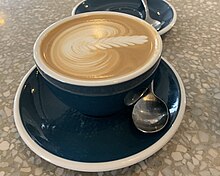
Coffee culture has become a significant cultural phenomenon in Australia.
Contents
- History
- 19th century
- Late 20th - Today
- Local taste and characteristics
- Coffee industry in Australia
- See also
- References
- External links


Coffee culture has become a significant cultural phenomenon in Australia.


According to the National Geographic, coffee came to Australia on the first fleet in 1788, but as traditional tea drinkers, it would be almost a century before coffee became part of Australian culture. Moving into the 1870s, coffee became popular due to the fashionable rise of Parisian coffee shops and the lobbying of the Temperance Movement, a movement of Christian women who protested anti-social drunken behaviour. [1]
Australia has a distinct coffee culture. The coffee industry has grown from independent cafes since the early 20th century.
After the second world war, Italian immigrants were the first to bring espresso machines to Australia. [2]
Cafe culture first flourished in Leichhardt in Sydney due to its high concentration of Italian immigrants. [3] Several Italian coffee names were eventually switched, with the caffè lungho the long black and the espresso becoming the short black. [3]
In 1952, the first espresso machines began to appear in Australia and a plethora of fine Italian coffee houses were emerging in Melbourne and Sydney. Pellegrini's Espresso Bar and Legend Café often lay claim to being Melbourne's first "real" espresso bars, opening their doors in 1954 and 1956 respectively. This decade also saw the establishment of one of Australia's most iconic coffee brands, Vittoria, which remains the country's largest coffee maker and distributor. The brand has existed in Australia since 1958, well before it moved to the US. [4]
The flat white, regarded as "Australia's greatest culinary export," may trace its origins to Australia and New Zealand in the 1980s. Its popularity has since expanded to other countries, gaining traction in the UK and the US. [5]
The flat white, a shot of espresso with a larger ratio of froth and steamed milk, [6] first became popular in Australia in the 1990s [7] and its invention is claimed by a Sydneysider. [8] [9] The flat white has since become a classis for Sydneysiders. [6] The iconic Greek cafés of Sydney and Melbourne were the first to introduce locally roasted coffees in 1910. [ citation needed ] Melbourne is sometimes called the “coffee capital of the World” [10] [11] with its plethora of cafés and roasteries. [12]

Australians tend prefer a less sugary Coffee, preferring a pure rather than sugary variant. [6] Australian cafe culture is said to emphasize the quality of the beverage as well as the quality of the coffee making process. [2] Specialty coffee is in demand in Australia, with numerous boutique cafes. Such specificity coffees are characterised by innovations in either or both roasting and brewing process. [13] [2]
95% of Australian cafes are independently owned establishments. [2]
To this day, international coffee chains such as Starbucks have very little market share in Australia, [14] with Australia's long established independent cafés existing along with homegrown franchises such as The Coffee Club, Michel's Patisserie, Dôme in WA, and Zarraffas Coffee in Queensland. One reason for this is that unlike with the United States and Asia, Australia for many decades had already had an established culture of independent cafés before coffee chains tried to enter the market. [15] [ failed verification ] Australians are more focused on the specialty coffee culture, focusing on sourcing fresh coffee beans, roasting properly, and brewing the best coffee beans. [16] [17] [18] [19] [20]
Ristretto is a coffee beverage characterised by a smoother flavour because of its higher concentration due to lack of water. [2] The Australian iced coffee uses a cold brew instead of hot espresso. The Australian iced coffee does not involve blending and is able to incorporate different local flavours, ice creams and syrups. [2]
Australian coffee industry generates US$5.8 billion in revenue per year. [21] [22]
Australia currently produces a small volume of specialty coffee, harvesting up to 600 tonnes of green beans from about 850 000 trees every year. [23]
Coffee is grown in two main areas in Australia, northern New South Wales and Queensland, due to the subtropical climate of these regions. [24] In the 1870s an experimental coffee plantation was established at Waggrakine, Western Australia, but failed within three years due to the unsuitable climate. [25]

Espresso is a coffee-brewing method in which a small amount of nearly boiling water is forced under pressure through finely ground coffee beans.
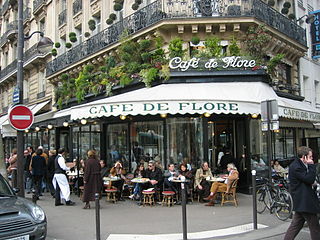
A coffeehouse, coffee shop, or café is an establishment that primarily serves various types of coffee, espresso, latte, and cappuccino. Some coffeehouses may serve cold drinks, such as iced coffee and iced tea, as well as other non-caffeinated beverages. A coffeehouse may also serve food, such as light snacks, sandwiches, muffins, fruit, or pastries. In continental Europe, some cafés also serve alcoholic beverages. Coffeehouses range from owner-operated small businesses to large multinational corporations. Some coffeehouse chains operate on a franchise business model, with numerous branches across various countries around the world.

Caffè macchiato, sometimes called espresso macchiato, is an espresso coffee drink with a small amount of milk, usually foamed. In Italian, macchiato means 'stained' or 'spotted', so the literal translation of caffè macchiato is 'stained coffee' or 'marked coffee'.

Coffee is a beverage brewed from roasted coffee beans. Darkly colored, bitter, and slightly acidic, coffee has a stimulating effect on humans, primarily due to its caffeine content. It has the highest sales in the world market for hot drinks.

Café au lait is coffee with hot milk added. It differs from white coffee, which is coffee with cold milk or other whiteners added.
Peet's Coffee is a San Francisco Bay Area-based specialty coffee roaster and retailer owned by JAB Holding Company via JDE Peet's. Founded in 1966 by Alfred Peet in Berkeley, California, Peet's introduced the United States to its darker roasted Arabica coffee in blends including French roast and grades appropriate for espresso drinks. Peet's offers freshly roasted beans, brewed coffee and espresso beverages, as well as bottled cold brew. In 2007, Peet's opened the first LEED Gold Certified roastery in the United States. Peet's coffee is sold in over 14,000 grocery stores across the United States.
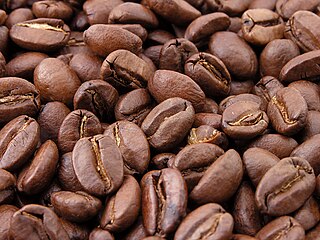
A coffee bean is a seed from the Coffea plant and the source for coffee. It is the pip inside the red or purple fruit. This fruit is often referred to as a coffee cherry, and like the cherry, it is a fruit with a pip. Even though the coffee beans are not technically beans, they are referred to as such because of their resemblance to true beans. The fruits most commonly contain two stones with their flat sides together. A small percentage of cherries contain a single seed, instead of the usual two, called a "peaberry". The peaberry occurs only between 10% and 15% of the time, and it is a fairly common belief that they have more flavour than normal coffee beans. Like Brazil nuts and white rice, coffee beans consist mostly of endosperm.
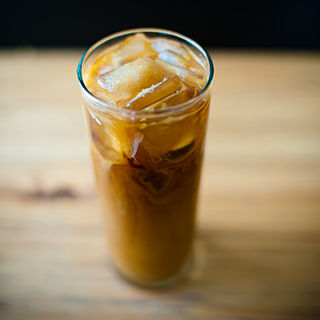
Iced coffee is a coffee beverage served cold. It may be prepared either by brewing coffee normally and then serving it over ice or in cold milk or by brewing the coffee cold. In hot brewing, sweeteners and flavoring may be added before cooling, as they dissolve faster. Iced coffee can also be sweetened with pre-dissolved sugar in water.

White coffee can refer to any of a number of different kinds of coffees or coffee substitutes worldwide.

Roasting coffee transforms the chemical and physical properties of green coffee beans into roasted coffee products. The roasting process is what produces the characteristic flavor of coffee by causing the green coffee beans to change in taste. Unroasted beans contain similar if not higher levels of acids, protein, sugars, and caffeine as those that have been roasted, but lack the taste of roasted coffee beans due to the Maillard and other chemical reactions that occur during roasting.

A flat white is a coffee drink consisting of espresso and steamed milk. It generally has a higher proportion of espresso to milk than a caffè latte, and lacks the thick layer of foam in a cappuccino. While the origin of the flat white is unclear, various café owners in Australia and New Zealand claim its invention.
Stumptown Coffee Roasters is a coffee roaster and retailer based in Portland, Oregon, United States. The chain's flagship café and roastery opened in 1999. Three other cafes, a roastery and a tasting annex have since opened in Portland, as well as locations in Seattle, New York, and Los Angeles,. Stumptown is owned by Peet's Coffee, which in turn is owned by JAB Holding Company. The company was an early innovator with cold brew coffee in nitro cans and have continued to develop other cold brew product innovations.
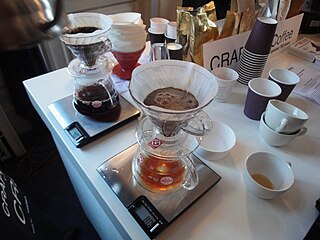
Coffee preparation is the process of turning coffee beans into liquid coffee. While the particular steps vary with the type of coffee and with the raw materials, the process includes four basic steps: raw coffee beans must be roasted, the roasted coffee beans must then be ground, and the ground coffee must then be mixed with hot or cold water for a specific time (brewed), the liquid coffee extraction must be separated from the used grounds, and finally, if desired, the extracted coffee is combined with other elements of the desired beverage, such as sweeteners, dairy products, dairy alternatives, or toppings.

Milk coffee is a category of coffee-based drinks made with milk. Johan Nieuhof, the Dutch ambassador to China, is credited as the first person to drink coffee with milk when he experimented with it around 1660.
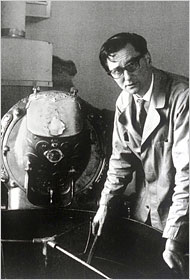
Alfred H. Peet was a Dutch-American entrepreneur and the founder of Peet's Coffee & Tea in Berkeley, California, in 1966. Peet is widely credited with starting the specialty coffee revolution in the US. Among coffee historians, Peet has been called "the Dutchman who taught America how to drink coffee." Peet taught his style of roasting beans to Jerry Baldwin, Zev Siegl and Gordon Bowker, who, with his blessing, took the technique to Seattle and founded Starbucks in 1971. Peet later distanced himself, however, from the Starbucks trio as they experimented with ultra-dark roasts. "Baldwin never learned anything from me," Peet was later quoted as saying.
Third-wave coffee is a movement in coffee marketing emphasizing high quality. Beans are typically sourced from individual farms and are roasted more lightly to bring out their distinctive flavors. Though the term was coined in 1999, the approach originated in the 1970s, with roasters such as the Coffee Connection.
Seattle is regarded as a world center for coffee roasting and coffee supply chain management. Related to this, many of the city's inhabitants are coffee enthusiasts; the city is known for its prominent coffee culture and numerous coffeehouses.
Countries have cultivated coffee beans into various vehicles to satisfy needs unique to each country. Whether it be for energy, socialization, or tradition, the cultivation of coffee has served as a motivating force of the world. The modernization of coffee and its unique forms across cultures are markers of tradition and modern changes across continents. Coffee culture appears in the way in which people consume coffee, the way they make it, and where coffee is served and shared. Each of these factors combined reflects the lives of the people in these countries and the importance of coffee across the world.
Starbucks Reserve is a program by the international coffeehouse chain Starbucks. The program involves operation of worldwide roasteries; currently six are in operation. Also part of the program are 28 coffee bars preparing Starbucks Reserve products, what Starbucks considers its rarest and best-quality coffees, usually single-origin coffees. Some Starbucks Reserve coffee is also sold in about 1,500 of the chain's traditional outlets.